ISSN ONLINE(2319-8753)PRINT(2347-6710)
ISSN ONLINE(2319-8753)PRINT(2347-6710)
|
Dr. S. Shanmugan Research Center of Physics, Dhanalakshmi College of Engineering, Dr.V.P.R. Nagar, Manimangalam, Tambaram, Chennai – 601 301, Tamilnadu, India. |
| Related article at Pubmed, Scholar Google |
Visit for more related articles at International Journal of Innovative Research in Science, Engineering and Technology
A single slope single basin solar still has been provided with a dripping arrangement to pour saline water drop by drop in the basin. The system has been tested with dripping of saline water and different energy absorbing materials like pebbles, black granite stones, and concrete stones. It has been found that the concrete stones in the basin with dripping of saline water to maintain least water depth have validated with the experimental results. Experiments were conducted in climate conditions of Chennai [latitude 13º 04’N, long 80º 17’E] in Tamilnadu from February to October 2013 with least water depth in basin use of energy absorbing materials. The experimental result which use of absorbing materials high production rate in concrete stones with compared other energy absorbing materials.
Keywords |
| Basin solar still, absorbing materials, Drip, thermal efficiency. |
INTRODUCTION |
| [1] Kalidasa Murugavel and Srithar have conducted experiments for the still up to a minimum depth of water and different wick materials like light cotton cloth, sponge sheet, coir mate and waste cotton pieces, and aluminum rectangular fin arranged in different configurations in the basin. [2] Tiwari et al., have studied the comparative performance of an active solar distillation system integrated with FPC, concentrating collector, evacuated tube collector with and without heat pipe and tried to evaluate the theoretical yield. It has been concluded that the still integrated with evacuated tube collectors had shown better results than the other collectors. Sampathkumar et al., [3] have made an attempt to investigate a newly deign solar still coupled with an evacuated tube collector experimentally. It was found that the maximum productivity of the still is increased when coupled with evacuated tube collector. The maximum production rate of the solar still coupled with and without evacuated tube collector is found to be 7.03Kg/day and 3.225Kg/day. Researchers have reviewed the performance of inverted absorber solar still [4] Rahall Dea et al. and found that thermal efficincy of inverted absorber solar still is thrice than that of the normal solar still. Sampathkumar et.al., [5] have studied the performance of the single basin solar still augmented with evacuated tubes and inferred that the daily production rate of the solar still is increased by 49.7% and increased by 59.48% by using black stones incorporated with evacuated tubes. Narjes setoodeh et al., have modeled and determined the heat transfer coefficient in a basin type solar still using computational fluid dynamics [CED]. It has been concluded that the CED is a powerful tool for design, parameter analysis and diagnostic purpose of solar still. Ajeet kumar [6] have made an attempt to find the optimum water depth and orientation for maximum yield of a double slope solar still. It has been concluded that the highest output corresponds to the minimum water depth and a gain of 60% of distillate output by orienting in the North – South directions. Rajaseenivasan et al., [7] have used various different wick and porous materials like black cotton cloth, jute cloth, waste cotton pieces, clay pots facing up and down and mild steel pieces in double basin and single basin solar still. They found double basin solar still with mild steel plates found more productive compared with other materials. In this paper, a single slope single basin solar still with s energy absorbing materials has been tested experimentally. The analysis of the solar still has been tested with dripping of saline water drop by drop in the basin with different energy absorbing materials like pebbles, black granite stones, and concrete stones. The various stones absorbing materials which are the parameters energy transfer like solar radiation, ambient, glass cover, water temperature, distillate output, efficiency and hot water production with system of the discussion. |
MATERIAL AND METHODS |
| Design of the system |
| The photograph of the experimental energy absorbing materials in a single slope single basin solar still is shown in the Figure 1a, 1b, 1c, 1d,1e and 1f. The still consists of outer and inner enclosure made of plywood with dimension of 1.3 x 1.3 m and 1.25 x 1.25m. The gap between the enclosures is filled with glass wool having the thermal conductivity of 0.0038 W/mK. The height of the back wall is 0.03m and front wall of 0.10m. The glass cover of thickness 4 mm is used as the condensing surface and the slope of the glass cover are fixed as 11º which is equal to the latitude of the location (Chennai). The still is made vapor tight with the help of metal putty. The j-shaped drainage channel is fixed near the front wall to collect the distillate yield and the output trickled down to the measuring jar. The basin of the still is made of copper sheet in the basin and painted black to absorb more solar radiation. A special arrangement has been made to pour saline water drop by drop in the basin to energy absorbing materials maintain least water depth. Figure 1d, the arrangement is made of heat resistant pipes with drip button fixed at regular intervals of 0.10m horizontally in the basin. The single slope single basin solar still was consisting of a copper sheet used for fabricating the still with a water depth of 0.5 to 1cm. Figure 1b, the basin inner side fixed a copper coil and serpentine heat exchanger made of copper with length 5.0m and diameter of 0.01m was welded to the upper surface area absorber plate and energy storage materials of the still. |
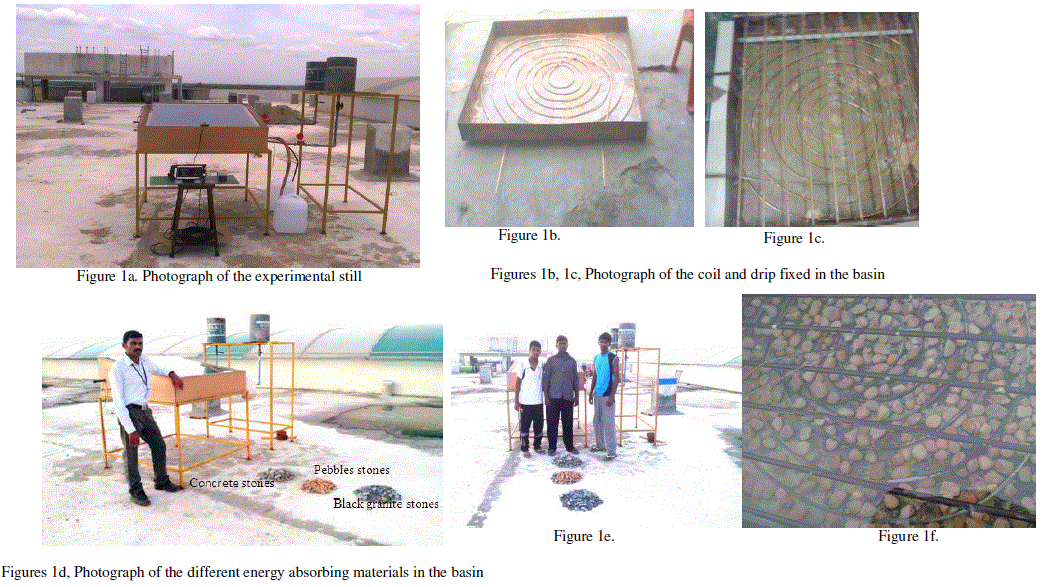 |
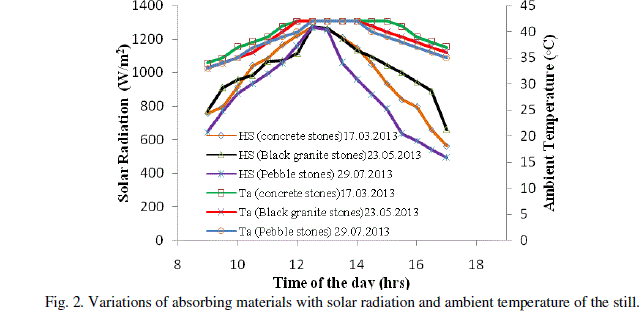 |
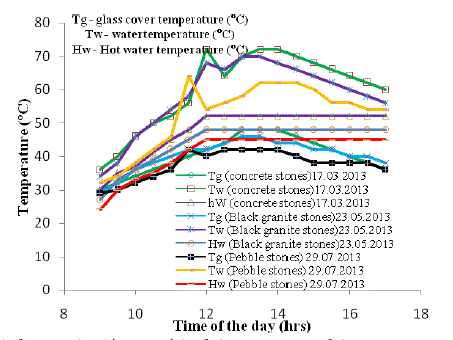 |
| Figures 1e, 1f, Photograph of the inside use of energy absorbing materials in the basin The gold water inlet fixed water flow meter an insulated tank was used as a fluid flowing through the heat exchanger to extract the heat from the saline water inside the basin area of the still under the open cycle continuous flow heating mode in 11.00am to 5.00pm. An insulation water tank was fixed at a relatively high place to achieve the required pressure difference needed for water flowing. The hot water outlet was connected to the storage tank via an insulation pipe to minimize heat loss. The basin energy absorbing materials temperature, saline water temperature, condensing cover temperature of the still and inlet, outlet hot water temperature of the system has been measured by fixing copper-constantan thermocouples which has been calibrated initially. Solar radiation intensity and ambient temperature have been measured with solar radiation monitor and digital thermometer. Experiment has been carried out from 6 am to 6 am of 24h duration with compare ordinary basin type still and drip button use basin still for during summer days at Department of Physics, Dhanalakshmi college Engineering, Chennai – 601 301 [latitude 13º 04’N, long 80º 17’E], Tamilnadu, India. |
| Experimental analysis of a single slope single basin solar still |
| The following assumptions have been made to write the energy absorb in the system. |
| (i) There is no temperature gradient throughout the condensing glass cover surface. |
| (ii) The system is made vapor tight such that there is no vapor leakage from the still. |
| (iii) The condensing glass cover and water surface are parallel due to small inclination of the glass cover. |
| (iv) The hot water is natural circulation mode to the still during sunshine hours in the basin. |
| (v) The governing heat transfer coefficients in the still are temperature dependent. |
RESULTS AND DISCUSSION |
| A single slope single basin solar still with absorbing materials in the basin of hot water production in the system has been analyzed experimentally. The experimental observation during time for February to October 2013 for one of the typical days has been measured of the temperature elements of the still. The input energy storage materials various parameters for the still as well as the natural sources are worried for local conditions in Chennai, Tamilnadu, Indian. |
| The several of the solar radiation and ambient temperature for one of the typical days have been depicted in the fig 2. It has been observed that the several of solar radiation and ambient temperature for the typical days measured of the still. The graph shows that the solar radiation and ambient temperature increase reaches maximum during 12pm to 2.00pm and then decreased gradually. The system is energy absorbed stone materials maximum solar radiation and ambient temperature in 1273 W/m2 and 42°C obtained. Fig. 3. Show the several energy absorbing materials of glass cover and basin water temperature of the still. It has been observed that the glass cover and water temperature for internal heat transfer from water to glass cover is provide with different absorbing materials in the basin. To compare the various stones with the concrete stones, black granite stones and pebble stones reach the glass cover and water temperature is maximum value of 42°C & 72°C, 42°C & 68°C and 42°C & 64°C at 12hrs with the system. |
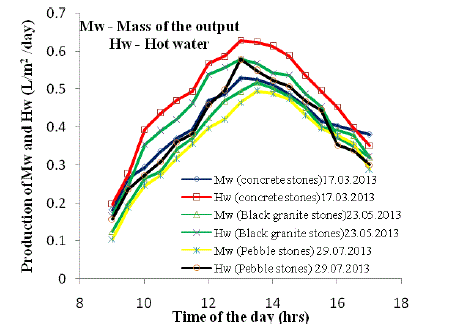 |
| It is energy transfer through concrete stones received the heat exchanger tube absorb energy from continues hot water temperature 52°C, 48°C and 45°C at during 11Am to 17pm. Since the thermal capacity is high, more time has been taken for internal heat transfer mode. |
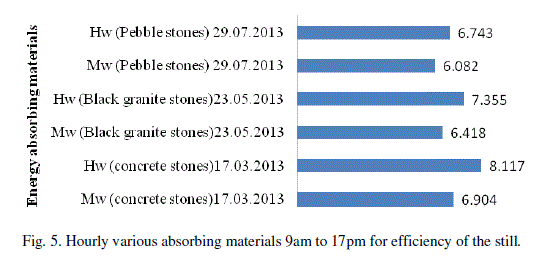 |
| Fig. 4. Show the several energy absorbing materials of distillate output for a single slope single basin solar still. It has been observed energy from distillate out is higher then with working hours of the still. The concrete, black granite and pebble stones of distillate output in the still are 6.90, 6.40 and 5.95 L/m2 and hot water 8.10, 7.34 and 6.78 L/m2 for during 9am to 5am and night time collection stones of the still is 1.5, 1.1 and 0.9 liters and hot water 1, 0.8 and 0.6 liters. |
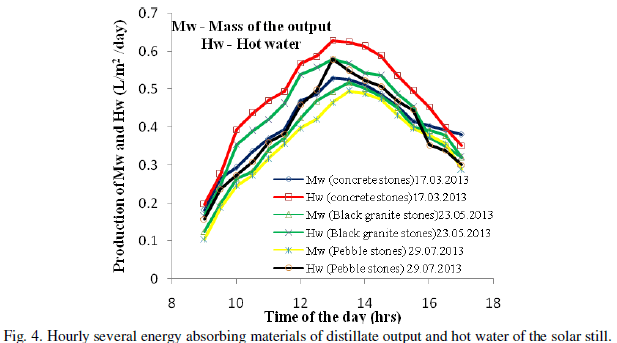 |
| It has been found that the concrete, black granite and pebble stones 24hrs total collection of water 8.40, 7.50 & 6.85 Liters/day. The different energy absorbing materials 24hrs total collection of hot water is 9.10, 8.14 and 7.38 Liters/day. The single slope single basin solar still uses in concrete stones of drip production in drinking water and hot water have been produced higher than compare with black granite and pebble stones. The various absorbing materials are density, thermal conductivity and specific heat capacity in the table 1. Fig. 5. Various absorbing materials for efficiency of the still. It is found that the efficiency of the still is higher than the concrete stone efficiency and than compare with other energy storage materials. The concrete stones improved maximum efficiency for the still is found to be 17% other stones respectively. Table 1. |
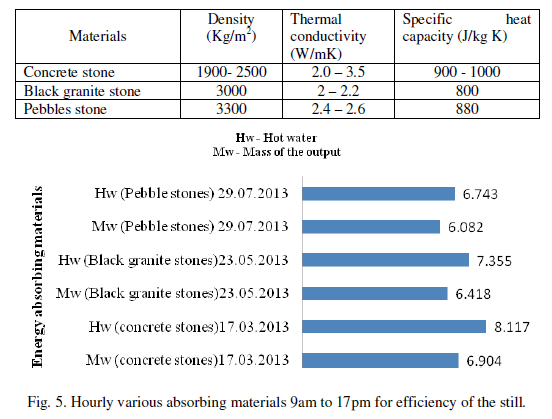 |
CONCLUSION |
| A single slope single basin solar still with energy absorbing materials these results the following has been drawn. |
| 1. The performance of the solar still is concrete stones higher compared with the other energy storage materials. |
| 2. The total distillate yield of the still is found to be 8.40 liters/day. |
| 3. The single slope single basin solar still for drip using with efficiency is increased. The maximum instantaneous efficiency of the still is 17%. |
| 4. A solar still has been analysed during February to October, it is possible to find the performance with concrete stones of the still can be found by using the proposed thermal model. |
| 5. The system daily hot water given 9.10 Liters/day. |
ACKNOWLEDGEMENT |
| I express my sense of gratitude to Dr. B. Janarthanan, Asst. Professor Dept of Physics, Karpagam University, Coimbatore, who helped me to explore in this field. I express my sincere thanks to Dr. V. P. Ramamurthy, Chancellor, Dhanalakshmi College of Engineering and Chairman and Managing Trustee, for providing financial help to complete this project work successfully. |
References |
|